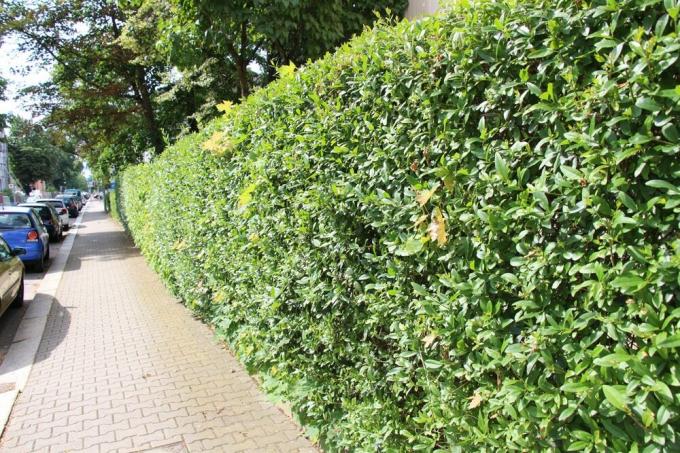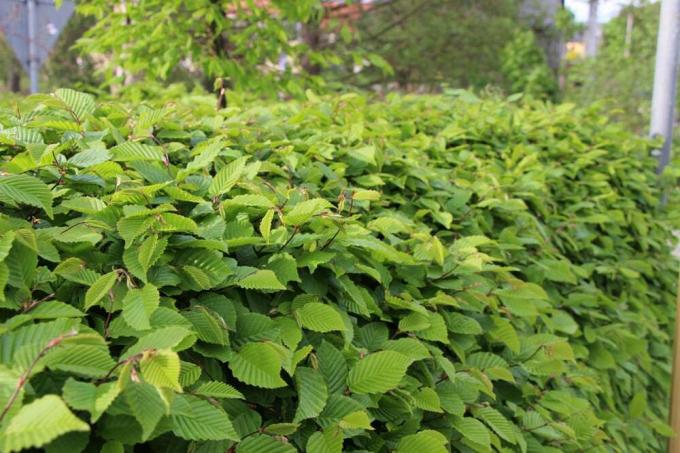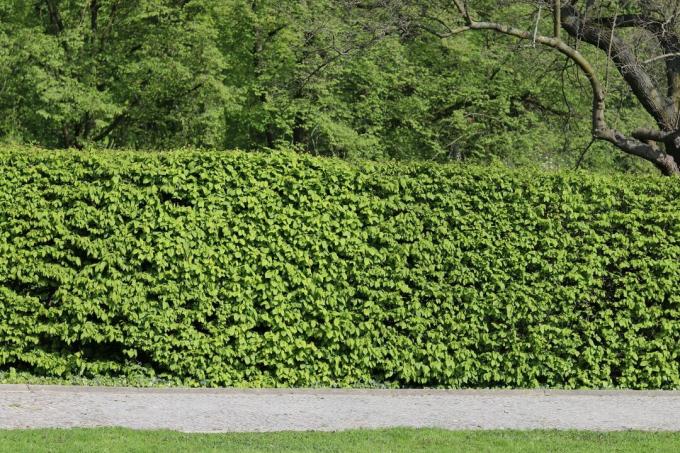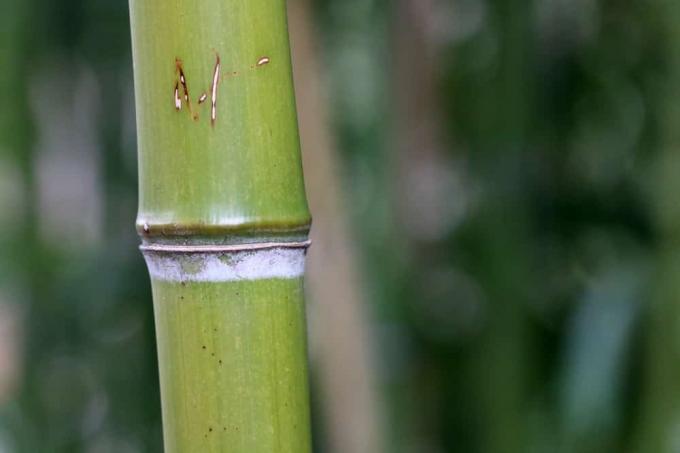

Table of contents
- Concretely defined time window
- Grooming cuts are allowed – with one restriction
- care
- Façade greening counts as a hedge
- exceptions to the rule
- Observe regional regulations
- Sensitive penalties
- Conclusion
Since 2010, the legislature has regulated the pruning of hedges, shrubs, living fences and other woody plants with the amendment to paragraph 39 of the Federal Nature Conservation Act. Among other things, the regulations stipulate time limits that every garden owner should be aware of. The aim of the decree is primarily to protect breeding birds and the entire ecosystem that can develop within hedges. Since the specific implementation is a matter for the federal states and municipalities, there are regional differences. Read what the Bird Protection Act says here.
Concretely defined time window
Paragraph 39 paragraph 5 of the Federal Nature Conservation Act (BNatSchG) stipulates that from 1 March to 30. September a hedge may not be cut off or planted on the stick. This regulation applies to all populated and unpopulated areas, including private gardens and green spaces.
Tip:
The technical term "putting on the stick" describes the radical pruning of a hedge up to about 20 cm above the ground. All shoots are shortened so that only one or two eyes remain on them, from which the plant can sprout again.
Grooming cuts are allowed – with one restriction
Gentle care cuts that serve to keep a hedge healthy are expressly permitted in the Bird Protection Act. These cutting measures may also be taken between 1 March and 30. to be carried out in September.
The only requirement is that there are no nests of breeding birds or similar habitats of small wild animals within the woods. According to § 39, paragraph 1, sentence 3, disturbing wild animals in their habitat without good reason is strictly prohibited, regardless of the season. How to act in compliance with the law:
- Before trimming the hedge, carefully inspect it for nests and small animals
- If the bushes are inhabited or if animals have created food supplies here, the pruning measure is postponed
- Otherwise, slightly shorten any branches that protrude from the mold
- The cleaning out of withered flowers is also permitted
- Deadwood may also be thinned out within the grace period
Since a radical rejuvenation cut in the middle of the vegetation phase does not make sense for most types of wood anyway is, the Federal Nature Conservation Act does not mean any real restrictions for the expert gardener care program. The best time for pruning ornamental and useful trees to shape and maintain them is in late winter between the end of December and mid/end of February.
care
Anyone who goes to work even though small animals have retreated into the hedge to hibernate or are simply looking for protection from frost and snow here is liable to prosecution.
Tip:
The Federal Nature Conservation Act makes a clear distinction between trees and hedges. Trees in home and allotment gardens are not subject to the ban on cutting and felling between 1 January March and 30. September. However, this only applies on the condition that there are no animal habitats in it or that other nature conservation regulations apply, such as the tree protection statute.
Façade greening counts as a hedge

The provisions of the Birds Protection Decree do not only apply to free-standing hedges. Rather, the cutting ban during the summer months also applies to facade greening. Here birds find a safe haven to raise their young, out of reach of cats and other predators. Between the 1 March and 30. September it is therefore forbidden to remove climbing plants on walls, fences or pergolas. A slight pruning is permitted if it can be ruled out in advance that there are no breeding grounds in the branches.
exceptions to the rule
The above-mentioned regulations relating to hedge trimming and bird protection do not apply if it is a measure ordered by the authorities. Among other things, the order refers to road safety. If a hedge poses a threat, the urgency of cutting measures or clearing is given priority over animal welfare. This applies, for example, when the hedge threatens to tip over onto the street or sidewalk after a storm. In this case, we recommend contacting the nature conservation authority or the regulatory office to be on the safe side when cutting and clearing work.
Another exception is viewed critically by conservationists. The law says that for permissible construction projects, a small amount of woody vegetation may be removed if it hinders the realization of the construction project. In the absence of a precise definition of 'minor', animal rights activists sense a back door for arbitrary clearing of hedges and shrubs. In fact, this measure is already subject to an official examination as part of the building application, which takes place with the appropriate sensitivity for the protection of bird life.
Observe regional regulations
The legislator transfers the implementation of the law on bird protection to the federal states and municipalities. The defined period from 1 March to 30. Of course, September must not be shortened at the state level. However, an extension of the time window is also permitted, as is a stricter interpretation. This flexibility is due to the fact that not all regions of Germany have the same flora and fauna. The following two examples illustrate the regional differences according to which the hedge trimming regulation can be interpreted:
In North Rhine-Westphalia becomes § 39 para. 5 of the BNatSchG verbatim. Hedge trimming and sitting on sticks are not permitted between these dates. The interpretation is justified on the one hand with bird protection. On the other hand, the radical pruning of the branches down to their sticks is seen as a serious incision in the regional landscape.
In Hamburg on the other hand, said paragraph is interpreted in a more differentiated way. In this federal state, the grooming cut should not be done before the 24th month. take place in June, St. John's Day. In doing so, no more than the most recent increase may be shortened.
We therefore recommend that you find out about the specific regulations that apply in your federal state and your municipality. It is not uncommon for small communities to pursue individual animal welfare goals and draw up correspondingly strict regulations that property owners and gardeners follow must.
Tip:
In addition to nature conservation, noise protection is a top priority in Germany. Always use a powered hedge trimmer in residential areas during permitted hours of use. As a rule, these are on weekdays from 9 a.m. to 1 p.m. and from 3 p.m. to 5 p.m.
Sensitive penalties

With significant fines, the legislature is giving emphasis to its decrees relating to hedge trimming and bird protection. Depending on the federal state, gardeners will be asked to pay a considerable fee if they disregard the legal regulations. In Lower Saxony, for example, the illegal removal of hedges is punishable by up to 25,000 euros. In Bavaria, the fine is up to 15,000 euros. The penalties are imposed regardless of whether the violation was intentional or negligent.
Conclusion
Bird protection is important in Germany when it comes to trimming hedges and trees. The Federal Nature Conservation Act states unequivocally that between 01.01. March and 30. September no hedge may be cut, planted or even cleared. Anyone who disregards this ordinance can be fined up to 25,000 euros. In principle, moderate grooming cuts are permitted within this grace period. Of course, the scissors should only be used when no birds or other small animals have chosen the hedge as a nursery for their offspring. This requirement also applies during the winter months, because disturbing wild animals within their habitat is prohibited all year round. If, on the other hand, hedges pose a risk to traffic safety or if an official measure is applied, the bird protection behind them is downgraded. Since the concrete implementation of paragraph 39 in the BNatSchG is a matter for the federal states, gardeners should familiarize themselves with the regional regulations before trimming a hedge.
 Home editorial office
Home editorial office
Learn more about hedges

Hornbeam hedge: 17 tips for care
Hornbeams (Carpinus betulus) are most commonly used as topiaries or hedge plants. They are actually not beeches at all, but belong to the birch family. The hornbeam is very robust, easy to care for and, in contrast to the common beech, not poisonous.

How fast does bamboo grow? | Information about growth
In domestic gardens, bamboo is usually used as a privacy screen or as a decorative solitary plant. The rapid growth, which can reach several cm a day, is impressive. It depends on the bamboo variety, care and the prevailing microclimate.

How fast does cherry laurel grow? | accelerate growth
The cherry laurel is a fast and densely growing tree. After planting, it usually only takes a few years for the young plants to grow into a tall, dense and evergreen hedge. In addition, growth can be accelerated by additional precautions.

Creating a mixed colorful hedge: 9 ideas for a mixed hedge
If you don't like it monotonous, you can also create a mixed hedge instead of a hedge from a single, evergreen plant species. There is a wide range of colorful hedges to choose from. There are special flowering hedges, ones for birds, scented ones, or for insects and butterflies.

Yellow cypress | 9 tips for care, pruning & growth
The yellow cypress is one of the most common hedge plants in our gardens. No wonder: it combines a great look with an opaque growth. How to properly care for them, cut them and generally promote their growth is here.

Thuja brabant turns brown or yellow: what to do? 8 common causes
When Thuja brabant turns yellow or brown, various factors can be responsible - but care mistakes are often the trigger. We reveal which factors are involved and how they can be counteracted.



